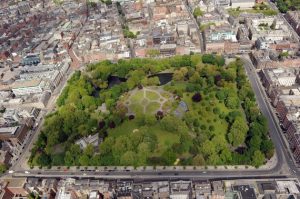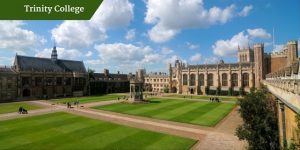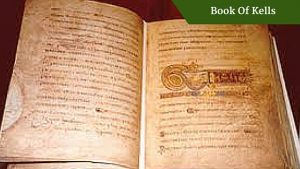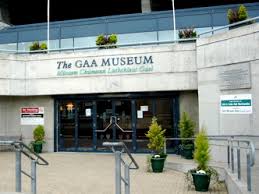
Dublin City
Dublin’s fair city is the capital of Ireland and also the largest city. Sitting on the river Liffey, Dublin (Baile Átha Cliath in Irish) is also called Dubh Linn, meaning Black Pool. It’s home the houses of Parliament, Dáil Éireann – Houses of the Oireachtas, the meeting places of the Government of Ireland and also the Four courts, with Ireland’s Supreme Court and High Court based here. With the only Luas system in Ireland (light tram) it’s easy to find your way around the busy city.

Guinness Storehouse | Kilmainham Gaol |Grafton Street
As a tourist it can be difficult to know where to begin your tour of Dublin so here a few tips on mixing some culture with the liveliness and traditions of Dublin!
The GPO (General Post Office) in the capital is not just a post office it’s a historical building steeped in Irish history. It is an iconic building, 100 years ago during the 1916 Easter Rising it was used as the headquarters for the uprising’s leaders. This rebellion changed the course of Irish history and eventually led to their independence from English reign. The building, along with much of Dublin, was left in ruins after a fire broke out during the rising, it was later restored once Ireland was an free and independent country. It is a beautiful 200 year old building and is still operational as the headquarters of An Post (Ireland’s Postal system). There are regular tours running through this magnificent building.
Kilmainham Gaol (Jail) was first built in 1796 and is one of the largest unoccupied jails in Europe. Public hangings used to take place in front of the prison but there were very few hangings from the 1820’s onward. However, many of the leaders of the 1916 Easter rising were executed in Kilmainham Gaol. Seen at the time as a place of suffering and oppression it’s no surprise that the jail was shut down as a functioning prison by the Irish Free State in 1924. The restoration of Kilmainhan Gaol was completed in 1971 and opened to the public.
St Patrick’s Cathedral founded in 1191, is the largest church in Ireland and named after St Patrick, who baptised Christians nearby over 1500 years ago. It’s the National Cathedral of the Church of Ireland and major refurbishment took place in 1870’s as it was feared the building was nearly collapsing.
The beauty of the Cathedral can be seen throughout, from the stained glass to the sculptures it has been a resting place for many famous Irish names such as Jonathan Swift (writer of Gulliver’s Travels). This is a must for any tourist as it’s not just your average church, there is so much to see here it is definitely worth putting a few hours aside!
A popular tourist attraction Trinity College is recognised for its academic excellence world-wide, founded in 1592 it is Ireland’s most prestigious universities. Up to the 20th Century men were the only scholars allowed entry to Trinity College, this changed in 1904 when women were admitted to the college as full members for the first time.
The Long Room Library in Trinity College house 4.25 million books and as a legal deposit library it’s entitled to hold every publication of every book in Britain and Ireland. This impressive and lavish library must be a treat for all the scholars and academics who are fortunate enough to study there. The library is also home to the infamous Book of Kells.
Containing the Four gospel of the New Testament written in latin, is the Book of Kells. This ancient book is from the 9th Century and was found in the Abbey of Kells, Co. Meath. The stylistic detail and Celtic art throughout the book is breathtaking. A digital version of the book was created by Trinity College and means the reader can have the experience of going through the book page by page.
It’s all in the name! The Guinness Storehouse, the home of Guinness, the beverage the Irish are known for. In 1759 Arthur Guinness famously signed the 9,000 year lease for the storehouse. On the tour you get to learn the history of Guinness and how to pour the perfect pint, there’s definitely a skill to pouring a guinness!!
Of course an important part of the Guinness tour is tasting the ‘Black Stuff’, some need to put a bit of blackcurrant in the pint to drink it as it has quite a strong kick! It is jokingly said that God created alcohol so the Irish won’t take over the world. Guinness is definitely enough to stop anyone in their tracks!
For over 800 years Dublin Castle has stood in the heart of Dublin and was originally built on a Viking site. It was used as a military fortress. The inauguration of the very first president of Ireland took place here and so did every one that followed. It is now used a lot also for State receptions and can be closed at short notice for Government business. Very little of the original medieval building remains above ground as most was destroyed in a fire in 1673. However, the regal theme has remained consistent throughout and is a magnificent building to visit.
On the grounds of Dublin Castle are the Dubh Linn (Dublin) Gardens and are said to be where the original Black Pool (Dubh Linn) lay of the namesake Dublin. The style of the garden has a very celtic feel and is a peaceful open space.
There are 3 branches of the National Museum of Ireland in Dublin and the branch as seen in the photograph above is the Museum of Archaeology. It contains so famous examples of celtic pieces so as the Ardagh Chalice, the Tara Brooch and the Derrynaflan hoard. There are also further back in time prehistoric pieces from the Iron Age. It’s fascinating how such a small Island such as Ireland can have so much history and physical artefacts to prove how ancient Ireland is.
Although known as home GAA (Gaelic Athletic Association), and has hosted thousands of matches and concerts, Croke Park is a bigger part of history than many people realise. Bloody Sunday is a date marked in Irish history. On the 21st of November 1920, during the War of Independence, a match was taking place in Croke Park with 5,000 spectators. British soldiers unleashed gunfire into the crowd, killing 16 civilians. Croke Park still hosts major GAA matches and finals today.
Don’t know much about GAA or the history? Take a trip to the Museum right beside Croke Park and learn everything about the sports. There’s also displays of all the jerseys, representing all counties in Ireland. So pick your favourite county and support your team!!
The Temple Bar area is on the Southern bank of the River Liffey, this very popular district is bustling with bars and restaurants giving all a taste of traditional Irish food, music and ‘craic’. There are a couple of stories about how Temple Bar got it’s name. One claims it was named because it had the first Jewish temple built in Ireland. The ‘bar’ refers to the refusal of Catholics to allow any of the Jewish Community to enter any of the nearby properties. It is more likely the name came from Sr William Temple, an English Scholar at Trinity College, he had his home and gardens in the area. Either way Temple Bar is worth a visit to take in the electric atmosphere of Dublin.
Shopping Dublin
As a very busy city Dublin is renowned for its’ shopping experience, with popular streets like Grafton Street, Henry Street and William Street (and so many more), there are shops galore in the heart of Dublin City! With Market stalls on many of the older streets it gives a feel of traditional Dublin and the market stall workers can be heard throughout the streets, shouting about their best bargains. There are also within the city several shopping centres, plenty of opportunity to treat yourself or buy gifts for loved ones!

Stephen’s green
St Stephen’s Green is a city centre park in Dublin, like a micro Central Park! Designed by William Sheppard the park was officially opened to the public in 1880. During the 1916 Easter Rising, St Stephen’s Green also had its’ part to play, 200 Irish Citizen Army volunteers occupied the park. Trenches were dug and barricades erected in the park, bullet holes can still be seen in the arch over the main entrance of the park.
We can’t complete our tour of Dublin without mentioning Molly Malone. She is a fictional character from a very popular Dublin song, it is known as the unofficial anthem of Dublin and also refer’s to ‘Dublin’s Fair City’. In the song Molly is a fishmonger selling cockles and mussels and there is a statue on Suffolk Street (previously on Grafton Street) to represent the melody of Dublin.
This was just a few of the many interesting places to see in Dublin, the Fair City, there are so much to do in this electric city and that’s only a taste of what Ireland has to offer. I hope you enjoyed reading about the spectacular places!
If you are interested in a Private Tour of Dublin and would like more information, please click on the Enquire button below:
Alternatively, if you would like to call us directly Toll Free from the US or Canada the number is 1 888 793 0416
All the best,
Mike Ryan
Have you checked us out on Trip Advisor yet? To have a look at what our guests have to say about our Customized Tours Ireland packages, simply click the Trip Advisor icon below:
Why not check out our Social Media Page too for news, reviews and lots lots more…




















 Previous post
Previous post 





